“Cunard Lines” R.M.S. Aquitania
1913 to 1950 - She also served in World War I & II.
Please Note: Firefox and some other Search Engines may not be suitable
Use Google Chrome for this Web Page to load perfectly!

Please Note: All ssMaritime and other related maritime
sites are 100% non-commercial and privately owned, thus ssmaritime is NOT
associated with any shipping company or any other organisation! Although the
author has worked and been involved in the passenger shipping industry for well
over 60 years, but due to his old age and poor health, he was forced to retire.
Yet, he has completed well over 1,365 Classic Liners, Passenger-Cargo Liners as
well as humble converted C3 converted Migrant Liners, which has transported countless
thousands folk to the new world, as well on vacations’. I trust the
features online will continue to provide Classic Liner and Ship enthusiasts
both the information they are seeking, but more so provide a great deal of
pleasure and relive many happy memories!
Please
Note: Postcards, photographs & other images
are either from the author’s private collection, unless stated otherwise.
A special thank
you to ssmaritime supporters Eric Davidson (Liverpool - UK),
Pieter ver Brugge (Ghent
- BE)
Luis Leforge
(Le Havre
- FR) and Don
Reynolds
(New York
- US) for their kind assistance and photographs

The artist
impression of the R.M.S. Aquitania’s is from after her 1920 refit
Page Two
Please Note:
This is an extensive multi page feature covering a very special liner, the
R.M.S. Aquitania, and if you have arrived at this page via a search engine, you
will find that this is Page Two of the “Aquitania”
feature, thus I suggest that you visit the Page One first by using this LINK.
Page One covers
the ship’s construction, her interiors to her maiden voyage and her early
Trans-Atlantic return voyages from Liverpool to New York.
Page Two sees
her requisitioned by the British Admiralty to enter World War One services, and
this page will include the three roles she operated in during the Great War. 1.
as an Armed Merchant Cruiser, 2; a Troop ship and 3; a Hospital ship. After the
War she was refitted and returned to civil duties until World War Two when she
became a Troop Ship once again. I will conclude Page Two with an extensive list
of her specifications and other details, etc.
Then there is also Page Three, this is
a page that covers every aspect regarding her massive power plant and other
machinery, etc! You will find a link to
the “Aquitania’s Power Plant” at the
bottom of this page, together with other relevant pages.
A Brief Intro:
The “Aquitania” was
a very special and a spectacular Passenger Liner to say the least! She was one
of those grand four stackers that was built especially
for the Trans-Atlantic trade to New York,
and her public venues were nothing short from spectacular!
Recently I located this incomplete item and it
needed some work still to be done to it. Thus I decided, although I had long
been retired that I would try and finally finish it, but I am sorry, this will
be my very last ssmaritime.com feature. I trust that you will enjoy it!
Reuben Goossens.

R.M.S.
Aquitania is seen as built
*************************
As we learned on Page One that the
magnificent R.M.S. Aquitania departed on her maiden voyage from Liverpool to New York
on May 30, 1914, after which she made only several further return voyages. But
sadly things in Europe were in turmoil, and sadly the “Aquitania”
was forced to cease her services due to World War One having commenced on July
28, 1914!
World War One:
Four days after the war commenced, on August
2, 1914 “Aquitania”
was officially requisitioned by the British Admiralty to become an Armed Merchant
Cruiser (A.M.C.). She was converted at the Cunard dock in Liverpool,
and her luxurious and decorative furnishings and other elements were removed
and placed into storage, whilst she was being armed with ten 6” guns and
was painted in that drab War time grey livery. Her conversion was completed on
August 7, and she was officially commissioned into the Royal Navy on that same
day.
On August 8, the H.M.A.M.C. Aquitania (Ml.56)
commenced her first war patrol on the Western Approaches of the UK,
in the Irish Sea and the North Atlantic
and did so until August 16.
Then on August 22, 1914, she headed off on her
second patrol, but during this patrol, she collided during heavy fog with the
“British Leyland Line” ship, S.S. Canadian just off the “Old
Head” of Kinsale along the coast of Ireland,
which crushed the Aquitania’s
bow. The “Canadian” had incurred considerable damage and thus she
also headed to a ship yard for repairs, but thereafter she continued sailing
until 1917, when she was torpedoed and then sunk just off Fastnet Rock,
Ireland.

The 9,309
Tonne S.S. Canadian
With the Aquitania having returned to Liverpool
and being repaired that took from August to December. During this time the
Admiralty decided to withdraw the “Aquitania”
from her AMC duties, as she simply did not prove to be the right ship for the
role, and operating her proved to be far too costly. Thus her guns were removed
and upon completion in December she was laid up at Liverpool.
However, the Admiralty then decided for a more
useful purpose for her, and they requisitioned her to become a troopship, a
role that she was built to do at her construction.
Officially on June 18, 1915, she was
requisitioned by the Admiralty for her new role and she was converted into a
“Troop Ship”. When completed she had room between 5,000 to 6,000
plus troops.
On June 25, 1915, H.M.T Aquitania departed on
the first of three voyages as a troopship to the Dardanelles and at times she
would be running alongside the “Britannic” or the “Mauretania”.
Combined they transported some 30,000 men to the battlefield between May and
August of that year.

H.M.T.
Aquitania is seen at anchor at Mudros
Harbour
Whilst transporting troops from Liverpool to Mudros (at the Greek island
of Lemnos)
in July 1915, Aquitania narrowly
avoided a torpedo fired from a suspected Austrian submarine. The incident was a
near miss with the torpedo passing ‘some fifty feet astern.
She was then rapidly converted at Mudros for her to be used as a hospital transport ship. She
operated one voyage from Mudros to Southampton
carrying around 2,400 wounded soldiers from the Dardanelles to England.
But when she returned to the UK,
due to Britain’s
failure at ‘Gallipoli’ the “Aquitania”
was given a full conversion that saw her refitted into a full-fledged operating
Hospital ship. This commenced in August 1915, she was converted at Southampton
and upon completion she had a capacity of 4,182 beds.

H.M.H.S.
Aquitania
She was able to care for many wounded on
board, as a good number of grand venues became large wards as well as operating
theatres, etc. The wards were to be found in such grand venues like the “Carolean” style First Class Smoking Room, as well as
the magnificent “Baroque” style “Palladian Lounge”. The
ship was repainted into the internationally-recognised Hospital Ship colours,
with buff funnels, a white hull with a broad green band and three red crosses
along each side of her hull. From April 1916 up until January
1917, H.M.H.S. Aquitania safely carried over 25,000 wounded troops.

H.M.H.S.
Aquitania seen at full speed bound for the UK

Wounded soldiers being loaded onto the H.M.H.S. Aquitania
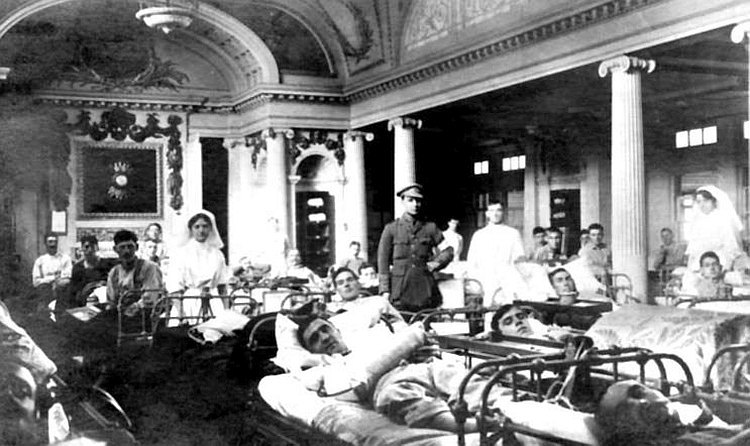
Above
& below: The First Class Palladian Lounge and
Smoke Room were transformed into wards
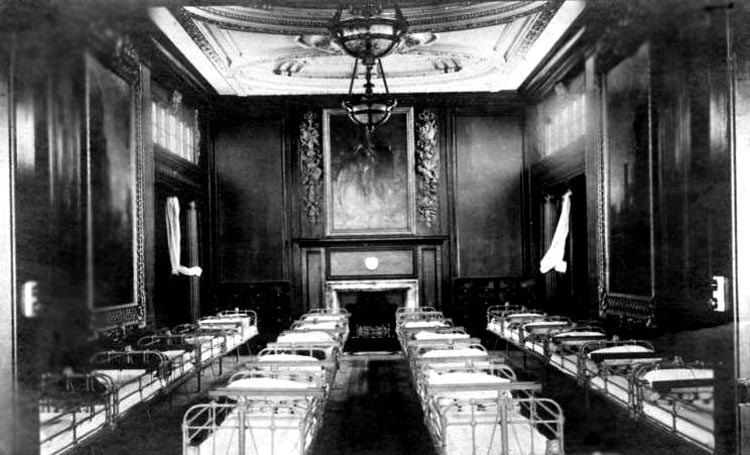
She was used as a hospital ship during the
Dardanelles campaign, collecting wounded soldiers at Mudros,
Lemnos Island,
Greece,
and taking them back to the UK.
She continued to serve in this role until April 10, 1916.

Above we see the H.M.H.S. Aquitania at anchor
at Mudros and the small vessel at her side is
delivering further wounded troops that had arrived from Gallipoli. On the left
is another smaller Hospital ship.
Returned to Cunard Line:
Then on April 10, 1916 whilst she was in the UK,
she was decommissioned and officially returned to the Cunard Line. Thereafter
the “Aquitania” was sent to Belfast
where she arrived at the “Harland & Wolff” shipyard. There she
was refitted as a luxury passenger liner again, but it seems that she was laid
up.
Then, sadly on November 21, 1916, the
“White Star” Hospital Ship the “Britannic” was
torpedoed and she sunk with 50 lives lost, but thankfully 1,106 persons were
rescued.
Days after the sad loss of the H.M.H.S.
Britannic in November she was requisitioned by the Admiralty for her to return
and operate as a hospital ship once again. Thus, she had a rapid internal
makeover and the H.M.H.S. Aquitania returned to her role as a hospital ship
operating in the Mediterranean
from early December 1916 through to late January 1917.
When her service was completed she was laid up
in the Solent
from late January to November 1917.
Then in November 1917 the
“Aquitania” along with the “Mauretania”
as well as the “Olympic” were requisitioned by the US Government to
be used as US troopships. The request was approved by the Ministry of Shipping
and the three ships headed for the USA
in December 1917.
Thus in 1918, the “Aquitania”
was back on the high seas now in the American troopship service, but she was
now under the command of Captain James
Charles.
Her role was transporting both US and Canadian troops to Britain
and she would carry an average of 6,000 troops on each voyage. Many of these
voyages departed from Halifax,
Nova Scotia,
Canada
where her spectacular colourful “dazzle” paint scheme was captured
by artists and photographers, including one “Antonio
Jacobsen”.

U.S.S.
Aquitania seen with her “dazzle” war paint-scheme

However on one voyage the “Aquitania” transported
just over 8,000 men. During her nine voyages for the US,
she transported around a total of 60,000 men.
However, not every voyage ran smooth, for
during her 8th US trooping voyage which departed on October 2, 1918 started
well, but a week later on October 9, she collided with the Sampson-Class destroyer,
U.S.S. Shaw DD-68, some 40 miles south of Portland, England. With Commander William
A.
Glassford
in command, the U.S.S.
Shaw
was steering a zigzag course, when suddenly her steering gear jammed causing
her to cross the bow of the “Aquitania”.
A massive damage of 90 ft of the Shaw’s
bow was completely cut off and destroyed, and sadly 16 of her men were killed
during the collision. Both ships were able to make port under their own power.
Obviously the Aquitania’s
crew came to the “Shaw’s”
assistance, as well as providing medical help as needed.

Above
& below: the U.S.S.
Shaw
DD-68 seen prior the collision and her massively damaged bow

Finally on November 2, 1918, the
“Aquitania” departed New York
for the official last US trooping voyage with 5,717 troops on board.
When the hostilities finally ended in 1918, Britain
and France
stood victorious over Germany
and Austria
and they signed an unconditional surrender at Versailles.
*************************
Back to Civil Duties:
At last, the “Aquitania”
could return to the commercial service she was intended for. However, Cunard
Line was not the same company it had been before the war, for they had lost a
huge number of ships, in fact it was 22 of their ships, including of course the
magnificent “Lusitania”
that had been lost. Due to there being a good number of captured German liners
available, some would now join the Cunard fleet including the impressive 52,000
GRT, S.S. Imperator, which Cunard had renamed the “Berengaria”
and she replaced the lost “Lusitania”.
On February 19, 1919 R.M.S. Aquitania departed
for her first voyage after the Armistice, but during her first three voyages
she was operated especially to repatriate troops from Liverpool and Brest
to New York.

The
“Aquitania is seen returning to Hoboken,
New Jersey
late in February 1919 filled with US soldiers

Above we see
four of the African American officers of the 377th Infantry who arrived on
board the “Aquitania” in Hoboken
late in February 1919. From left to right are; Lieutenant C. L. Abbot, Captain
Joseph L. Lowe, Lieutenant A. R. Fisher of Lyles, Indiana, winner of
Distinguished Service Cross and Captain E. White.
Whilst below
we see the US
77th Division soldiers who were also on the “Aquitania” arriving at
Hoboken
in February 1919

On June 14, 1919 this fine liner returned to
her commercial passenger duties but not having had a major refit as yet, she
was temporarily operated on what was called an “austerity service”
from Southampton,
sailing via Cherbourg
to New York.
Aquitania’s Massive Refit:
In December 1919
the “Aquitania” headed for the “Armstrong
Whitworth & Co” ship-yard on the Tyne at Newcastle,
Scotland, where
she would be comprehensively refitted for her post-war service.
Work on the “Aquitania”
took place from December 1919 trough to June 1920, and there was a great deal
of work in order to bring her back to the luxury liner she was post war. But
whilst this was being undertaken, it was the perfect opportunity to convert the
ship to oil burning. The company realised that converting her from coal to oil
would mean that only 50 stokers would be required, opposed to the 350 that where
needed to maintain her coal fired bunkers, thus it would save a great deal in
her operating costs.
As we know, her original fittings and art
pieces, etc, had been removed prior to her being refitted for military use
pre-war, thus all that would now be returned to the ship, and it was brought
out of storage and re-installed. Sadly, some of the original furniture and
fittings had to be replaced due to some items having been damaged during
wartime storage.

R.M.S.
Aquitania’s new look, note forward topside, as a new Bridge was built
above the previous wheelhouse
The “Aquitania
received another addition and that was a brand new wheelhouse that was located
topside directly above the original wheelhouse. The fact is that her officers
had been complaining from when she was built regarding the poor visibility over
the ship’s forecastle, and thus the new Bridge topside would make a
huge difference. Also installed was a new “Sperry
Mark IV
Gyro Compass” making this the very first time such a device was used on
board a merchant ship!

R.M.S. Aquitania is seen at the “Armstrong
Whitworth” shipyard
and her new Bridge has just been completed
During the refit several new facilities where
added on board such as a branch of the “Midland Bank” being
installed for her first class passengers, as well as the installation of an
“Information Bureau” in the First Class Foyer.

R.M.S. Aquitania
seen in preparation for her departure from the “Armstrong-Whitworth
Shipyard on the Tyne
in May, 1920

R.M.S.
Aquitania is seen on the Tyne
having just departed from the “Armstrong
Whitworth”
shipyard
After sea trials north of Scotland
early in July, “Aquitania” departed Newcastle
and she was returned to her owners the “Cunard Line” in Liverpool.
Upon arrival at Liverpool,
Cunard ensured that their luxury liner would be completely up to scratch and
ready to be the finest of ships once again. She was fully stocked up and
immaculately prepared for her regular Trans-Atlantic passenger services.
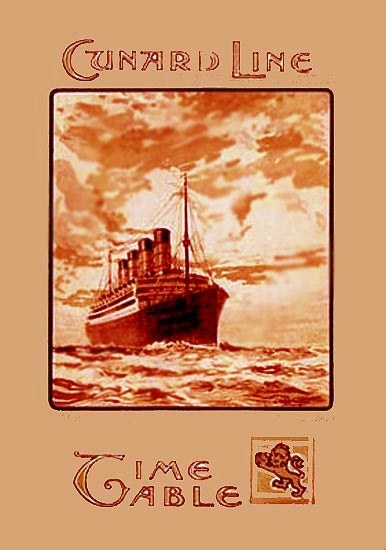
A British
1920 Cunard Time Table
In the United States,
the company was already promoting the return of the famed, “Ship Beautiful” by various newspaper posters and
advertisements, but also a drawing promoting her grand size.

Promotional
material of the R.M.S. Aquitania created especially for the American market
With 2,433 passengers having booked on her
first official post war voyage, the R.M.S. Aquitania departed Liverpool on July
17, 1920 for Trans-Atlantic voyage bound for New
York.
This voyage proved to be a huge success as the weather was simply sublime, and
passengers enjoyed the fineries of this magnificent liner. In addition she
maintained an excellent speed, whilst at the same time clearly proving that the
oil-fuelled propulsion was indeed a great deal cheaper than the coal-fuelled
system. “Aquitania” arrived in New York
Harbour
to a fine welcome back, and she was filmed as part of a special pioneering
documentary.

A fine
view of the R.M.S. Aquitania after her splendid refit, with her new Bridge
visible topside
Her
original wheelhouse area can be seen above, and note that it was plated in with
12 small portholes added.
After her voyage from Liverpool to New York,
she returned to Southampton,
where she was now home ported. The months and year that followed were equally
as promising and passenger numbers remained very high on each voyage, despite a
stewards’ strike in May 1921.
At the beginning of the decade, the
“Aquitania” was the only large liner in Cunard’s service
due to the Mauretania
undergoing repairs after a fire on board. And thus 1921 was an exceptional year
for the Aquitania;
and she broke a record by transporting around 60,000 passengers during the
year. In 1922, R.M.S. Mauretania rejoined her, and
the “Aquitania” operated together with the “Mauretania” and “Berengaria”
as a trio that became lovingly known as “The Big Three.”
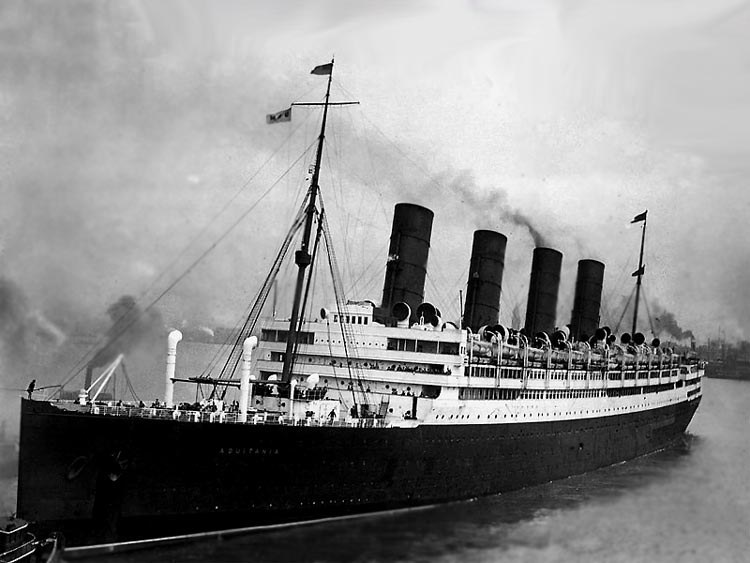
“Aquitania
is seen arriving at New York

Photograph above: Here we see the Ocean Dock at Southampton
in 1923, and there are four great legends of the sea in port. From left to
right we see the “White Star” liners, R.M.S. Homeric seen pulling
away as she is departing, the R.M.S. Olympic see bow on. Then from
“Cunard Line” we see the R.M.S.
Aquitania with the R.M.S.
Berengaria
berthed aft of her.
However late in 1924, there was a new
restriction passed by the United States
regarding immigration and this caused the number of Third Class passenger
numbers to decline significantly. From an average of 26,000 Third-Class
passengers transported by the
“Aquitania” each
year during the early 1920’s, but the figure fell to just around 8,200
Third-Class passengers in 1925. Therefore it was decided that the number of the
crew would be reduced to around 850 from the original 1,200. Suddenly
Third Class was no longer the key to the profitability of the liner, and
therefore Cunard was forced to adapt. Therefore, Third Class was updated and it
became “Tourist Class, which offered an upgraded service, but at a low
price.

The
“Aquitania” is seen in New York
in 1926
In 1926, the ship underwent a major overhaul,
which reduced the passenger capacity from around 3,300 to around 2,200. During
further annual winter refits in 1927, 1928 and 1933 her accommodations were
continuously updated and even a theatre/cinema was installed during her 1936 winter
refit.

The new
theatre, cinema installed on the “Aquitania” in 1936
The Stock Market Crash of 1929:
Following the stock market crash of
1929, many ships were affected by the economic downturn and reduced traffic. “Aquitania” found
herself in a tough position.

A 1929
Cunard Time Table

“Aquitania”
is seen in July 1930 whilst the pilot is leaving the ship in the Narrows
between Brooklyn and Staten Island
During a voyage in May 1931, President Franklin
D.
Roosevelt,
his son Elliott
Roosevelt
sailed on the R.M.S. Aquitania and on the photograph below they are seen
together with the Captain out on deck on May 11, 1931.


The R.M.S.
Aquitania is seen on the Atlantic
in May 1931
In November 1931, during one of her voyages
she encountered a massive storm, which saw her crash through the waves and even
a number of portholes were lost during the wild weather.
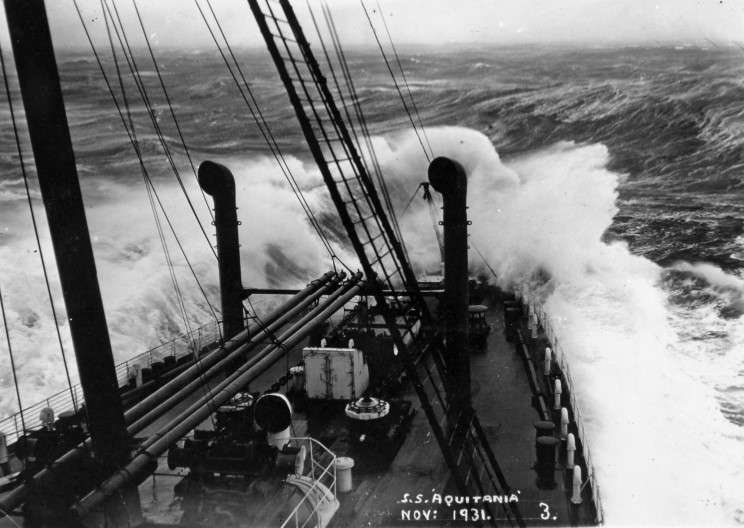
“Aquitania’s”
bow is seen crashing through the wild sea during a storm
Only a few could afford the costly passage on
her, thus in 1932 Cunard decided to send the “Aquitania”
on a well priced luxury Cruises. She would depart New York
on February 3, and crossed the Atlantic and sailed around the Mediterranean.

The “Aquitania”
is seen during her first Mediterranean cruise in February 1932
These proved to be successful, especially for
Americans who decided to head off on what was their “booze cruise”,
for American’s were sick and tired of their
country’s ‘prohibition’.

The
“Aquitania” is seen here during a cruise arriving at Naples
Italy
There were further cruises on this service,
but also other cruises to an ever popular destination being sunny
Bermuda,
and these were operated during the northern winter months.

With Pier
54 in New York
having been closed, the Aquitania
was the first to berth at the reopened pier in July, 1933

Aquitania
is shown in the floating dry dock at Southampton
in May, 1930
The ship
was having a new propeller installed to replace a damaged one

“Aquitania”
is seen the Southampton’s
floating dock on December 17, 1933 undergoing her annual overhaul
Note her
funnels having been capped
On January 24, 1934, the
“Aquitania” ran aground whilst she was still on the Solent
River,
but thankfully she was refloated later that day.

Above The
“Aquitania” sails from Southampton
in 1934, following Cunard’s merger with White Star on May 10, 1934. Both
house flags now fly from her aft mast. The R.M.S. Olympic can be seen berthed
in the background.
Below we see
the R.M.S. Olympic arriving in New York
in August 1934, and the “Aquitania”
is at her berth. These two ships will soon be the very last two four-stackers
left in service on the North Atlantic,
because their running mate the 1906 built R.M.S. Mauretania was taken out of
service in September 1934.

Cunard-White Star Line:

For financial reasons “Cunard
Line” and the “White Star Line” merged on May 10,
1934, to forming the “Cunard-White Star Line”. It was understood
that the company planned to retire the “Aquitania”
when the new R.M.S. Queen Elizabeth would
enter service in 1940. But in the meantime the R.M.S. Aquitania continued to
operate sailing from Southampton to the United States, in addition when WW2
commenced, the “Aquitania” would sail on for a further 10 years.

A new
Cunard-White Star Line postcard of the “Aquitania”
However due to the merger, the older ships,
such as the “Mauretania” and
the long serving “Olympic” and the “Homeric” were
laid up for five months and were then sold and headed to the breakers later in
1934. But thankfully due to her excellent speed the “Aquitania”
remained in service even though she was 21 years old.
Although numbers of passengers on all ships
including the “Aquitania” had
declined, she transported 13,000 passengers in 1934 compared to 30,000 most
years prior. The ship, however, remained popular and she remained one of
the busiest liner’s during the early 1930s.
The public continued to love the “Aquitania”
and she was Cunard’s most popular ship, be it for her Trans-Atlantic
services or her popular luxury cruises.
But once more on April 10, 1935, the
“Aquitania” went aground on “Thorne
Knoll”
in the Solent near Southampton,
but this time she was hard and fast and she remained stuck in the same position
for 26 long and costly hours.

The “Aquitania
is seen stuck on “Thorne
Knoll”
with the first tugs assisting on April 11, 1935
Some eleven tugs during the next high tide she
was pulled off and was free again. Although her hull had rested fast on the
bottom, that had been a huge strain for the ship, but thankfully the
“Aquitania” came out of this event almost unscathed. She was back
in service very quickly thereafter.
When Cunard’s magnificent new liner the R.M.S. Queen Mary entered
service in 1936, the company decided that it needed the “Aquitania”
to obtain a maximum speed of at least 24 knots to make her a suitable running
mate for “Queen Mary”
and she certainly had no trouble in obtaining that speed. Thus from 1936, 24
knot Trans-Atlantic passages had become the norm!

R.M.S. Queen Mary is seen departing Southampton
on her maiden voyage on May 27, 1936
In 1939 saw an even greater increase of the
wealthy passengers onboard R.M.S. Aquitania, even though she was then already
26 years old.

The R.M.S.
Aquitania is seen on the Atlantic
in 1937 sailing at a good 24 knots

R.M.S.
Aquitania is seen at Southampton
in the late 1930’s
Note on
the 2 photographs above that her Bridge has had a slight change and the window
section had been painted brown
However, when the new R.M.S. Queen Elizabeth entered
service as a troopship in February 1940, all the newspapers speculated that
“The Aquitania will
surely be sold and be broken up this year”. But they were very wrong, for
her overall performance continued to satisfy the company and thus the R.M.S.
Aquitania would sail on for quite some time yet.

Departing
for New York
on August 23, 1939
On August 23, 1939, R.M.S. Aquitania departed
on her very last peacetime voyage from Southampton
to New York
where she arrived on the 29th. Once her passengers had left the ship she and
other liners remained there as it was expected that a war was about to break
out.
*************************
World War Two:
On September 1, 1939, Adolf
Hitler’s
army had suddenly marched into Poland,
he had declared war, and this commenced World War Two.
During September of 1939, New
York
harbour had a highly selected group of great Ocean Liners at berth, as at pier
88 were the French Liner “Īle
de
France”
as well as the grandest liner of the times, the “Normandie”, whilst
berthed at pier 90 were the “Queen Mary”
and the “Aquitania”,
whilst at pier 92 was the Italian liner “Rex”.
All those plans to replace the
“Aquitania” with
the new “Queen Elizabeth” in
1940, was completely changed due to the outbreak of World War Two.
Below, on
September 16, 1939, the “Aquitania”
having had her superstructure, funnels and masts repainted in a grey
camouflage, she is seen arriving in New York
to an awaiting media, who had come out to meet her on a press boat.

Having arrived in New York, her captain had
been awaiting for her to be called up for war duties and soon enough the call
came and she returned to Southampton,
where she was immediately requisitioned on November 21, 1939, by the Admiralty
for use as a troopship with a capacity of over 7,000 troops.

The
“Aquitania” seen departing New York
in November 1939
Although
she had been painted in a dull grey camouflage this image does not show it well
The “Aquitania”
was originally designed to be able to carry some 7,400 soldiers, etc, after her
luxury fittings had been removed and was rapidly painted in that dull war grey
camouflage. “Aquitania”
was among a select group of large, fast liners converted into troop ships that
were capable of sailing independently without an escort transporting large
numbers of troops that were assigned worldwide as required. Sadly, these
ships were frequently termed as “Monsters” being due to their large
size. But London
requested, or better still “demanded” that the term be dropped and
it certainly was.
The “Aquitania”, “Queen
Mary”, “Queen
Elizabeth”, “Mauretania” (II), “Īle de France” and what is regarded as the most
beautiful ship ever built the S.S. Nieuw Amsterdam as well as some
slightly smaller ships, yet being liners capable of sailing independently with
a large troop capacity that accounted for much of the troop capacity and
deployment, especially during the early days of the war.
In December 1939, the now repainted battleship
grey H.H.S. Aquitania headed for Canada
as there she would be collecting Canadian troops and take them to Scotland.

H.M.T.
Aquitania is seen here in her war grey livery at sea, bound for Canada
Thus her initial troop transport operation was
taking American and Canadian troops to Scotland, and she sailed in Convoy TC1
in company with “Empress of Britain”, “Empress of
Australia”, “Duchess of Bedford”, “Monarch of
Bermuda”, HMS Hood, HMS Warspite,
HMS Barham, HMS Resolution,
HMS Repulse, HMS Furious, in December 1939.

H.M.T.
Aquitania at anchor in Scotland
and is disembarking US and Canadian troops per tender’s
Meanwhile, a massive transport of Australian
and New Zealand troops to Suez and North Africa, with possible
diversion to the United Kingdom if events required, was in planning with the
numbered convoys to be designated as "US" with the large Atlantic
liners assigned a role.
The fast convoy designated as US.3 was
composed of Aquitania and the liners Queen Mary, Mauretania, Empress
of Britain, Empress of Canada, Empress of Japan and Andes. Aquitania, Empress
of Britain and Empress of Japan, after embarking New Zealand troops
at Wellington in May, sailed escorted
by HMAS Canberra, HMAS Australia,
and HMNZS Leander to join the Australian component off Sydney on
5 May 1940.

H.M.T.
Aquitania departs Wellington New Zealand
on May 5, 1940
She was joined off Sydney
Heads
by the “Queen Mary” and the
“Mauretania” and the convoy sailed the same day to be joined by
the “Empress of Canada” from Melbourne and
then a stop was made at Fremantle (port
of Perth)
from 10 to 12 May, 1940, before the voyage intended to be for Colombo.
About midway to Colombo,
on 15 May, the convoy was rerouted due to the rapid German penetrations
into France with
the ultimate destination of Gourock,
Scotland
sailing via Cape Town,
South Africa
and Freetown,
Sierra Leone where
the escort was strengthened by various ships including the aircraft
carriers HMS Hermes and HMS Argus and
the battle cruiser HMS Hood. The convoy arrived in the Clyde and
anchored off Gourock on 16 June 1940.
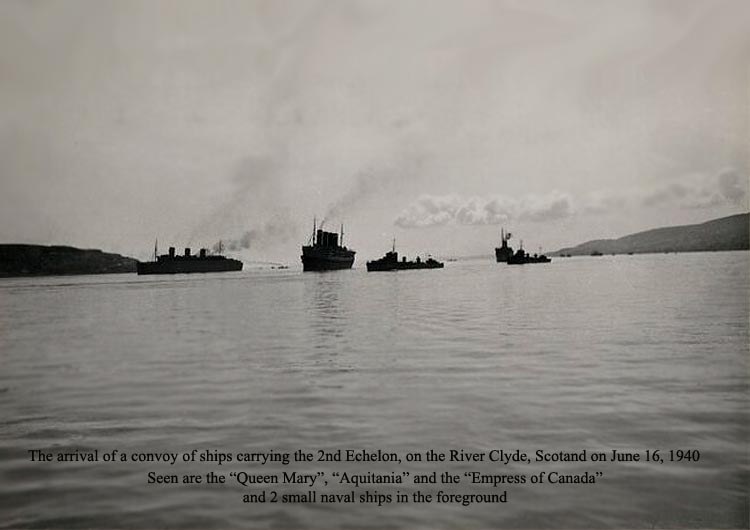
The Tragic Loss of the H.M.A.S. Sydney:
In November 1941 H.M.T.
Aquitania was at the British colony of Singapore,
and she sailed from there on November 19, to take part indirectly in the tragic
loss of the Australian cruiser H.M.A.S. Sydney.
H.M.A.S. Sydney had engaged in battle with the German 8,736 GRT,
auxiliary cruiser the “Kormoran”
(HSK-8). There has been unsubstantiated speculation that the “Kormoran” was actually expecting the
“Aquitania”, after German spies in Singapore
had notified the ship’s crew of the liner’s departure and was
heading their way, and that the “Aquitania” planned to ambush her
in the Indian Ocean west of Perth.

She may
look innocent, but she was a very dangerous heavily armed, auxiliary
cruiser “Kormoran” (HSK-8)
But instead the “Kormoran”
happened to encounter the H.M.A.S. Sydney on
November 19, 1941. Both ships were lost after a fierce battle.

The
Australian cruiser H.M.A.S.
Sydney
was sunk during a fierce battle on November 19
Tragically
all hands on board were lost, the German auxiliary cruiser “Kormoran” also sunk
On the morning of November 24, whilst
the “Aquitania” was heading for the
port
of Sydney
from Singapore,
she spotted and picked up twenty-six survivors of the German ship, but she
maintained radio silence and did not pass word until she was in visual range of Wilson's
Promontory on November 27. The captain had gone against orders not to
stop for survivors of sinking’s. Tragically there were no survivors
from H.M.A.S. Sydney.
Japanese enter the war in the Pacific:
December saw the outbreak of war in the
Pacific, then Japanese advances throughout Southeast Asia and they were
attempting to head for Australia,
necessitating the redeployment of defensive forces. On December 28, 1941,
the “Aquitania” and two smaller troop ships departed Sydney
with 4,150 Australian troops and 10,000 tons of equipment bound for Port Moresby,
New Guinea.
The H.M.T. Aquitania returned to Sydney
on January 8, 1942.
The next effort was reinforcement of Singapore
and the Netherlands East Indies with Aquitania transporting
Australian troops (whose equipment was in Convoy MS.1) as the single ship MS.2
convoy, under escort of HMAS Canberra. Originally, “Aquitania” was
to head
for Singapore,
but the danger from aircraft to such a valuable troop ship and with so many
troops on board caused a change of plans. Thus
the “Aquitania” departed Sydney
on January 10, sailing via Fremantle arriving on January 15, 1942 and she
anchored at Gauge Roads in the port

Aquitania is seen at Fremantle on January 15, 1942
She departed after a very short stay, and onboard
was the 8th Division’s 2/4th Machine Gun Battalion, who thought that they
were heading for the Middle East, but no they were heading to Singapore.
The “Aquitania” arrived in Ratai Bay at
the Sunda Strait on January 20 (Sunda Strait is a strait between the Indonesian
islands of Java and Sumatra) where the 3,456 personnel as well as some Navy,
Air Force and civilians were transhipped under a covering of naval force
to seven smaller vessels (six of these being Dutch K.P.M. ships) that
would take them to Singapore in convoy MS.2A. After all had disembarked, the
“Aquitania” returned to Sydney
arriving on January 31.
With the United
States
having entered the war, Aquitania (then with a troop capacity of
4,500) had been scheduled for troop transport duties from the United
States
to Australia
in February, but required repairs delayed that, mostly due to her deep draft,
which would have been hazardous in some Australian as well as intermediate
ports at Pacific
Islands.
Thus she spent March and April 1942 transporting troops from the west
coast of the U.S.
to Hawaii. Then
she was temporarily transferred from Pacific duties to support the
movement of troops from the United States
to the
United Kingdom,
sailing from New York
on April 30, in a large convoy that transported at total of 19,000
troops. On May 12, 1942 the “Aquitania” loaded
troops at Gourock,
Scotland,
who were heading for the war in the Middle East,
she departed in convoy WS19P on June 1. However with slow destroyers and heavy
weather; on June 7, the “Aquitania
broke away from the convoy and sailed independently, due to her far greater
speed with designation she was now listed as ‘WS19Q’. The
first port of call was Freetown
in West Africa
where she arrived on June 11, and she spent 48 hours there. Next was Simonstown,
South Africa,
where she arrived on June 20 and stayed for 3 days, then it was to Diego Suarez,
Madagascar,
where she arrived on June 30 and remained for 48 hours. She then headed for
Steamer Point, Aden
arriving on July 3, and remained there for 24 hours. Then she arrived at her destination
Port
Tewfik,
Egypt,
on July 8, 1942, and all troops disembarked there. H.M.T.
Aquitania’s return voyage was via Diego
Suarez,
Cape Town,
Freetown
and then back to Boston,
Massachusetts,
USA
where she would enter a Boston Naval Ship Yard in September 1942 for some
modifications and an increase of troop numbers.

“Aquitania”
is seen here in the Boston Naval ship yard
Thank you Don Reynolds (New York
- US) for your assistance and photographs
After her Boston
overhaul, by the end of September the
“Aquitania” would
be engaged in what was known as a “Triangular Troop Deployment’
sailing from the United States,
as
well as the United Kingdom
and the
Indian Ocean
regions.
As part of a major redeployment of Australian
troops had come from North Africa to the defence of Australia
and joined the offensive operations in the South-west of the Pacific. The
armed merchant cruiser H.M.S. Queen of Bermuda transported
the Australian 9th Division to Sydney
in Operation Pamphlet during January and February 1943.

Here we
see the Aquitania
(aft) and the Īle
de France
during “Operation Pamphlet” early in 1943

H.M.T.
Aquitania is seen arriving in Sydney
on February 27, 1943 at the conclusion of “Operation Pamphlet”

Another
photo of the Aquitania arriving in Sydney
on February 27, 1943, with the stern
In view of
the “Queen Mary”
which was known during the war as the “Grey
Ghost”
With the invasion of Europe in 1944, troop
deployments to Britain
depended heavily on the
H.M.T. Aquitania Together
with the other large troop ships, and no allowance could be made for
interrupting their service for any other transport requirements.
There was an embarkation in New York
of the “Special Navy Advance Group 56” (SNAG 56), and they were to
become “Navy Base Hospital Number 12” at the Royal
Victoria
Hospital at
Netley
in England,
a hospital that would receive countless casualties from Normandy.
H.M.T. Aquitania departed New York
on the morning of January 29, 1944 with some 1,000 Navy as well as 7,000 Army
personnel and she headed for and arrived at Gourock,
Scotland
on February 5, 1944.

H.M.T. Aquitania
arrives in Scotland
on February 5, 1944
Below we see
the “Aquitania” in a photo taken from the air, and she is seen
berthed at Sydney’s
Woolloomooloo wharf in December, 1945. The other ships that are seen are on the
left the aircraft carrier H.M.S. Implacable, the “Aquitania”
is in the center, in addition there is a large battleship seen on the far right
slightly in the background.

World War Two was very busy for the H.M.T.
Aquitania and she remained in mostly trooping service until 1948, and with
eight long years of military work, the “Aquitania” had
sailed over 500,000 miles, and she had carried close to 400,000 troops and
officers, as well as medical staff, to and from places as far afield as
Australia, New
Zealand,
the
South Pacific, Africa
(Middle East) Greece
and of course places around the Indian
Ocean.

The
“Aquitania” is seen entering the King George
V
dry dock at Southampton
in July, 1946.
*************************
Post War and ships fate:
After completing her official trooper duties “Aquitania” was
handed back to Cunard-White Star in 1948. She underwent a refit for passenger
service. She was then chartered by the Canadian Government for her to be used
to transport war brides and their children to Canada.

The voyage was more like a luxury cruise for those on board, as they
were all pampered and their children were so well taken care off and superbly
fed.
This final Canadian service created a special
fondness for Aquitania in Halifax
being the
port of disembarkation for these special voyages.

R.M.S.
Aquitania seen berthed at Halifax
with the R.M.S. Britannic ahead of her, this was during the summer of 1949
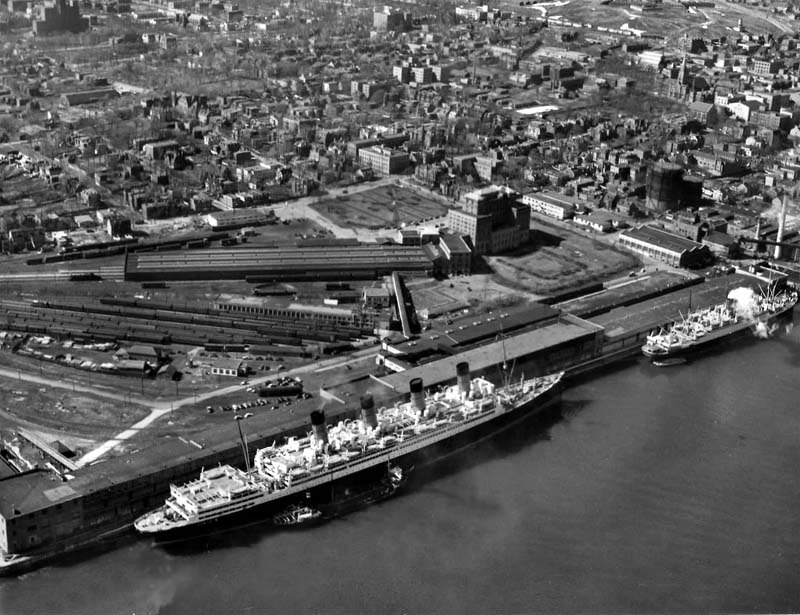
Two fine
Cunard liners, the grandiose “Aquitania” and the more intimate
“Ascania” are seen together in Halifax
during the summer of 1949
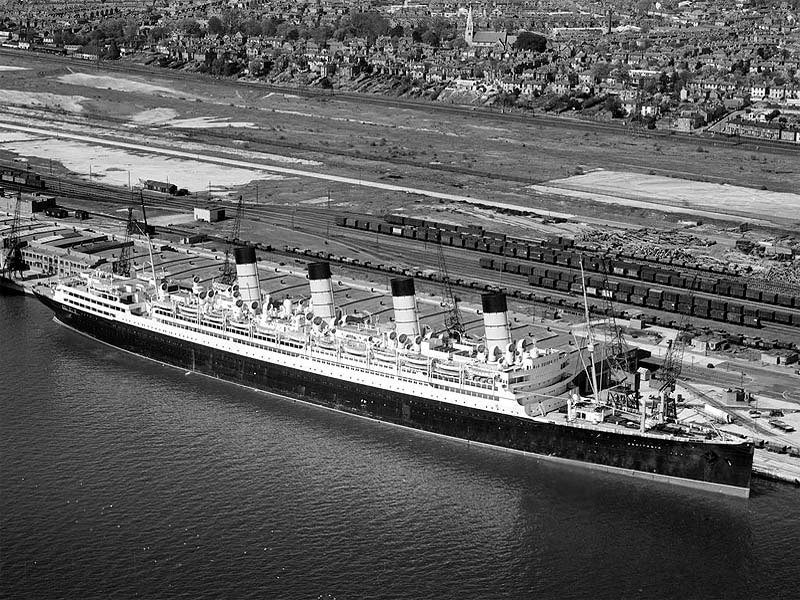
The
“Aquitania” is seen at Southampton
whilst she was berthed at the Western Docks in September 1949
With “Aquitania’s”
Canadian voyages having been completed in December 1949, the Cunard-White Star
Lines’ name had been changed in 1942, to just the - “Cunard
Line”.

Above we see
the R.M.S. Aquitania at Southampton’s
berth 108, early in December 1949, and she had just returned from her final
Trans-Atlantic voyage. On December 1, Cunard had announced that she would be
officially withdrawn from service on December 14.
The reason for the decision to take the “Aquitania”
out of service was due to the ship’s “Board of Trade” refused
to renew her certificate, due to the poor condition of the ship. Sadly the “Aquitania
had deteriorated rather badly, and it would have been far too expensive to
bring this old liner up to the current high safety standards, namely the fire
code regulations. But she was now in a bad shape, for her open decks were
leaking water into her interiors whenever it was bad rainy weather, the
bulkheads and her funnels were so badly corroded that someone managed to stick
their finger right through them. And then, even a piano had fallen through the
roof of a dining room from the deck above and believe it or not, that happened
during a corporate luncheon being held on board at that time, but thankfully
no-one was hurt. Thus all this signalled the end of the
once magnificent and luxurious R.M.S. Aquitania’s
operational life.
It was tragic that the Company had regained
their much loved ship and had given her a refit in 1948, to her return to
commercial services, but at least no other large liner had ever served this
long under a single ownership.
It is remarkable, but the “Aquitania” was
the only major passenger liner, as well as being the largest commercial ship to
serve in both, yes two World Wars. In addition she was also the very last of
the four-stacker’s (funnelled) passenger liner to be broken up.
In Conclusion:
Thus, when in December 1949 the “Aquitania”
was sadly found to be unfit for further commercial service, this great ship was retired from
service at the end of 1949 and she was sold several months later to be broken
up.

Above we see
the crew of the “Aquitania”
seen removing the furnishings on the dockside from the old liner on January 8,
1950. Vans would transport her furniture and fittings to a shed on Pier No 108,
where it was all displayed in lots, ready for the auction that commenced in
February.
She had been sold on February 13, 1950, to a
ship breaker, the “British Iron & Steel Corporation” of
Faslane, Scotland,
for £125,000.
On February 18, 1950 the Cunard flag was
officially hoisted down for the very last time and she was then officially
transferred (signed over) to “British Iron & Steel Corp”.
The “Aquitania”
departed Southampton
on February 19, 1950, with Captain R.G.B.
Woollatt
in command and she headed for Faslane, Scotland.

Above we see her departing Southampton
on February 19, 1950, for her very last voyage ever, to the breakers yard at
Faslane.

“Aquitania” is
seen arriving at Faslane on February 21, 1950

The “Aquitania”
is now arrives at the “British Iron & Steel Corp” yard on February
21
Due to her being such a well constructed ship, dismantling this big liner took close to a year to complete, and it
was a very slow process. Below we can see her being dismantled at the stern,
and a stern section is flying in the air as it has just been thrown over the
side, and it seems that someone has cut out the last letter of her name the
“A”. But then on October 12, 1950, during the breaking up, she was
suddenly swept by fire, which was extinguished, and breaking her up continued.

Thus the illustrious career of this great
liner had sadly come to an end, but the “Aquitania”
was a record breaker, for she did steam more than 3 million miles, with
450 return voyages. The “Aquitania” carried
an amazing 1.2 million passengers through her busy career at sea that now
spanned almost 36 years, making her the longest-serving “Express
Liner” of the 20th century.
But, her record was overtaken six years later
by the R.M.S. Scythia who served for 37 years. Then in 2008 Aquitania’s
service record was pushed to the third place, when the
“Queen Elizabeth
2” became the longest serving Cunard ship ever, having
served for 40 years.
As I stated earlier, she became a much loved
and admired ship by the Canadian’s, and thus her ‘Ship’s
Wheel’ and a fine large scale model of the
“Aquitania” is located at the “Cunard Exhibit” in
the “Maritime Museum of the Atlantic”, Halifax, Nova Scotia,
Canada - their museum images (thank you) are seen below.


*************************
Remembering
the Grandiose & Luxurious …
R.M.S. Aquitania

A view of
R.M.S. Aquitania just after her 1920 refit
R.M.S.
Aquitania’s Index:
Page One … (this
Page).
From Concept, Construction, Interior & exterior Photo Album,
her Maiden Voyage
and pre WW1 services.
Page Two …
Aquitania WW1, Civil service & WW2,
with her final days.
Page
Three …
Aquitania’s
Power Plant & more …
View a YouTube video on the Aquitania.
*************************
“Blue Water
Liners sailing to the distant shores.
I watched them come, I
watched them go and I watched them die.”

Featuring over 1,365
Classic Passenger Liners, Passenger-Cargo Liners & Classic Cruise Ships!
Or ENTER HERE
For interest:
Sadly an email service to ssMaritime is no longer available, due to the
author’s old age and chronic illness as well as being disabled, etc. In
the past ssMaritime received well over 120 emails per day, but Mr.
Goossens
can no longer handle same. He sincerely regrets this!
*************************
ssMaritime.com & ssMaritime.net
Where the ships of the past make
history & the 1914 built M.S. Doulos Story.
The Author has
been in Passenger Shipping & the Cruise Industry for well over 60 years
In addition he was
the founder of “Save the Classic Liners Campaign” in 1990.
Please Note: ssmaritime and associated sites
are 100% non-commercial and the author seeks no
funding or favours of any shape or form, never have and never will!
Photographs
on ssmaritime and associate pages are by; the author or from the author’s
private collection. In addition there are some images that have been provided
by Shipping Companies and private photographers or collectors. Credit is given
to all contributors. However, there are some photographs provided to me without
details regarding the photographer/owner concerned.
This notice
covers all pages; although,
and I have done my best to ensure that all photographs are duly credited
and that this notice is displaced on each page, that is, when a page is updated!
ssMaritime is owned & © Copyright by Reuben Goossens -
All Rights Reserved












































































